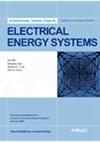{"title":"用于多机电力系统中发电机控制的动态COI跟踪概念","authors":"Z. Lan, D. Gan, Libao Shi, Y. Ni, T. Bi","doi":"10.1002/ETEP.163","DOIUrl":null,"url":null,"abstract":"In the conventional excitation control concept, the power angle and frequency of a generator are driven to a pre-designed operation point after the fault occurs. It is named as Constant Point Stabilization (CPS) concept in this paper. A novel concept, called dynamic Center of Inertia (COI)-tracking concept is proposed in this paper. In the concept, the power angle and frequency of each generator track the dynamic COI of the power system. Compared to CPS concept, a salient feature the suggested dynamic COI-tracking concept has is that the generators are not restricted to constant angle point or frequency any longer but track the dynamic COI trajectory of the system to keep synchronous in rotor angle and frequency. Wide area measurement system (WAMS) will be used to transform COI signals to each generator. The time delay within a certain limit of WAMS signals is permitted. To make comparison between the two concepts, the control system models based on the two concepts are first established. Then, using the back-stepping method, two robust controllers are designed to achieve the control objectives of the two concepts. At last, dynamic simulations are carried out based on a 2-area-4-machine test power system, and the control effects of the two controllers, together with that of the conventional AVR + PSS excitation system, are compared. Copyright © 2007 John Wiley & Sons, Ltd.","PeriodicalId":50474,"journal":{"name":"European Transactions on Electrical Power","volume":"18 1","pages":"50-64"},"PeriodicalIF":0.0000,"publicationDate":"2008-01-01","publicationTypes":"Journal Article","fieldsOfStudy":null,"isOpenAccess":false,"openAccessPdf":"https://sci-hub-pdf.com/10.1002/ETEP.163","citationCount":"8","resultStr":"{\"title\":\"Dynamic COI‐tracking concept for the control of generators in multi‐machine power systems\",\"authors\":\"Z. Lan, D. Gan, Libao Shi, Y. Ni, T. Bi\",\"doi\":\"10.1002/ETEP.163\",\"DOIUrl\":null,\"url\":null,\"abstract\":\"In the conventional excitation control concept, the power angle and frequency of a generator are driven to a pre-designed operation point after the fault occurs. It is named as Constant Point Stabilization (CPS) concept in this paper. A novel concept, called dynamic Center of Inertia (COI)-tracking concept is proposed in this paper. In the concept, the power angle and frequency of each generator track the dynamic COI of the power system. Compared to CPS concept, a salient feature the suggested dynamic COI-tracking concept has is that the generators are not restricted to constant angle point or frequency any longer but track the dynamic COI trajectory of the system to keep synchronous in rotor angle and frequency. Wide area measurement system (WAMS) will be used to transform COI signals to each generator. The time delay within a certain limit of WAMS signals is permitted. To make comparison between the two concepts, the control system models based on the two concepts are first established. Then, using the back-stepping method, two robust controllers are designed to achieve the control objectives of the two concepts. At last, dynamic simulations are carried out based on a 2-area-4-machine test power system, and the control effects of the two controllers, together with that of the conventional AVR + PSS excitation system, are compared. Copyright © 2007 John Wiley & Sons, Ltd.\",\"PeriodicalId\":50474,\"journal\":{\"name\":\"European Transactions on Electrical Power\",\"volume\":\"18 1\",\"pages\":\"50-64\"},\"PeriodicalIF\":0.0000,\"publicationDate\":\"2008-01-01\",\"publicationTypes\":\"Journal Article\",\"fieldsOfStudy\":null,\"isOpenAccess\":false,\"openAccessPdf\":\"https://sci-hub-pdf.com/10.1002/ETEP.163\",\"citationCount\":\"8\",\"resultStr\":null,\"platform\":\"Semanticscholar\",\"paperid\":null,\"PeriodicalName\":\"European Transactions on Electrical Power\",\"FirstCategoryId\":\"1085\",\"ListUrlMain\":\"https://doi.org/10.1002/ETEP.163\",\"RegionNum\":0,\"RegionCategory\":null,\"ArticlePicture\":[],\"TitleCN\":null,\"AbstractTextCN\":null,\"PMCID\":null,\"EPubDate\":\"\",\"PubModel\":\"\",\"JCR\":\"\",\"JCRName\":\"\",\"Score\":null,\"Total\":0}","platform":"Semanticscholar","paperid":null,"PeriodicalName":"European Transactions on Electrical Power","FirstCategoryId":"1085","ListUrlMain":"https://doi.org/10.1002/ETEP.163","RegionNum":0,"RegionCategory":null,"ArticlePicture":[],"TitleCN":null,"AbstractTextCN":null,"PMCID":null,"EPubDate":"","PubModel":"","JCR":"","JCRName":"","Score":null,"Total":0}
引用次数: 8
Dynamic COI‐tracking concept for the control of generators in multi‐machine power systems
In the conventional excitation control concept, the power angle and frequency of a generator are driven to a pre-designed operation point after the fault occurs. It is named as Constant Point Stabilization (CPS) concept in this paper. A novel concept, called dynamic Center of Inertia (COI)-tracking concept is proposed in this paper. In the concept, the power angle and frequency of each generator track the dynamic COI of the power system. Compared to CPS concept, a salient feature the suggested dynamic COI-tracking concept has is that the generators are not restricted to constant angle point or frequency any longer but track the dynamic COI trajectory of the system to keep synchronous in rotor angle and frequency. Wide area measurement system (WAMS) will be used to transform COI signals to each generator. The time delay within a certain limit of WAMS signals is permitted. To make comparison between the two concepts, the control system models based on the two concepts are first established. Then, using the back-stepping method, two robust controllers are designed to achieve the control objectives of the two concepts. At last, dynamic simulations are carried out based on a 2-area-4-machine test power system, and the control effects of the two controllers, together with that of the conventional AVR + PSS excitation system, are compared. Copyright © 2007 John Wiley & Sons, Ltd.


